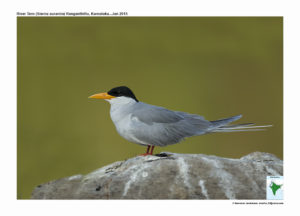River Tern

River Tern Sterna aurantia
Etymology:
- Sterna : Old English name “stearn” for terns , believed to be derived from Danish and Norwegian terne or Swedish tärna
- Aurantia :Latin word for Orange coloured derived from aurantia –orange
Vernacular Names: Sind: Kinai, Sans: Nadikurri, Pun: Dariaitaheri, Guj: Samanyadhomdi, Kenchipunchvabagali, Mar: BhartiyaNadisuray, Ta: Kulathuaala,Te: Ramadasu, Mal:Puzhaala, Hindi: NadiTehari
Distribution in India: Widespread resident in India.
Description: Size of 38–46 cm; wingspan of 80–85 cm. It has a black crown and black lores and deeply forkedtail. The upperparts are darkish grey; bill is stout and bright yellow; iris is dark brown; legs are red. The non-breeding adult has whitish forehead and forecrown, with black marks around eye to nape. The bill is dull yellow with dusky tip. The immature is grey above, flecked with buffy white and boldly marked with black chevrons; forehead and broad eye line are white; bill is dull ocher. The 1st-summer is very similar to adult, but with a few white feathers on crown and shorter tail streamers.
Habitat: It is found in breeding season on sandy islands in freshwater lakes and rivers, and estuaries. It is found from lowland up to 600 m .
Food habits: It eats fish, small crustaceans and insects. It feeds by plunge-diving. It feeds mainly over fresh water.
Breeding habits: They breed in Feb–May. First nests often flooded out, and re-laying occurs. They nest colonially, often with other terns, skimmers and Little Pratincoles. They readily mobs intruders, including hawks and corvids. The nest is a shallow scrape on bare sand. They lay a clutch of 3-4 eggs.The incubation period is 18–19 days. The young chick fed by adult are independent by 3 weeks after fledging.